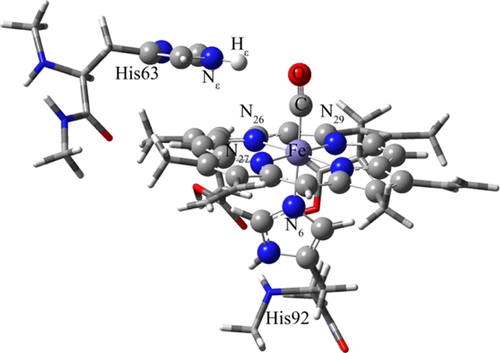当前位置:
X-MOL 学术
›
J. Phys. Chem. B
›
论文详情
Our official English website, www.x-mol.net, welcomes your
feedback! (Note: you will need to create a separate account there.)
Quasi-Static Two-Dimensional Infrared Spectra of the Carboxyhemoglobin Subsystem under Electric Fields: A Theoretical Study
The Journal of Physical Chemistry B ( IF 2.8 ) Pub Date : 2020-10-19 , DOI: 10.1021/acs.jpcb.0c06251 Hai Chao Ren 1, 2 , Lin Xiang Ji 3 , Tu Nan Chen 4 , Jiao Nan Yuan 5 , Yao Yao Huang 2 , Dong-Qing Wei 6, 7 , Guang Fu Ji 2 , Zeng Ming Zhang 1
The Journal of Physical Chemistry B ( IF 2.8 ) Pub Date : 2020-10-19 , DOI: 10.1021/acs.jpcb.0c06251 Hai Chao Ren 1, 2 , Lin Xiang Ji 3 , Tu Nan Chen 4 , Jiao Nan Yuan 5 , Yao Yao Huang 2 , Dong-Qing Wei 6, 7 , Guang Fu Ji 2 , Zeng Ming Zhang 1
Affiliation

|
There is no doubt that electric fields of a specific frequency and intensity could excite certain vibrational modes of a macromolecule, which alters its mode coupling and conformation. Motivated by recent experiments and theories, we study the mode coupling between the Fe–CO mode and CO-stretch mode and vibration energy transfer among the active site and proteins in carboxyhemoglobin (HbCO) under different electric fields using the quasi-static two-dimensional infrared spectra. This study uses iron–porphyrin–imidazole–CO and two distal histidines in HbCO as the subsystem. The potential energy and dipole moment surfaces of the subsystem are calculated using an all-electron ab initio (B3LYP-D3(BJ)) method with the basis set Lanl2dz for the Fe atom and 6-31G(d,p) for C, H, O, and N atoms. Although the subsystem is reduced dimensionally, the anharmonic frequency and anharmonicity of the CO-stretch mode show excellent agreement with experimental values. We use the revealing noncovalent interaction method to confirm the hydrogen bond between the Hε atom of the His63 and the CO molecule. Our study confirms that the mode coupling between the Fe–CO mode and CO-stretch mode does not exist when the subsystem is free of electric field perturbation, which is coupled when the electric field is −0.5142 V/nm. In addition, with the increases of distance between the active site and the His92, there is no vibrational energy transfer between them when the electric field is 1.028 V/nm. We believe that our work could provide new ideas for increasing the dissociation efficiency of the Fe–CO bond and theoretical references for experimental research.
中文翻译:

羧基血红蛋白子系统在电场下的准静态二维红外光谱:理论研究
毫无疑问,特定频率和强度的电场会激发大分子的某些振动模式,从而改变其模式耦合和构象。基于最新的实验和理论,我们利用准静态二维方法研究了Fe-CO模式和CO拉伸模式之间的模式耦合以及不同电场下羧基血红蛋白(HbCO)中活性位点和蛋白质之间的振动能量转移。红外光谱。本研究使用HbCO中的铁-卟啉-咪唑-CO和两个远端组氨酸作为子系统。使用全电子从头算(B3LYP-D3(BJ))方法计算子系统的势能和偶极矩表面,其中Fe原子的基本集为Lanl2dz,C,H的基本集为6-31G(d,p) ,O和N原子。尽管子系统尺寸减小,CO拉伸方式的非谐频率和非谐性与实验值吻合良好。我们使用揭示性的非共价相互作用方法来确定H之间的氢键His63的ε原子和CO分子。我们的研究证实,当子系统没有电场扰动时,Fe-CO模式和CO拉伸模式之间不存在模式耦合,而当电场为-0.5142 V / nm时,则不会耦合。此外,随着活性位点和His92之间距离的增加,当电场为1.028 V / nm时,它们之间没有振动能量转移。我们相信我们的工作可以为提高Fe-CO键的离解效率提供新的思路,并为实验研究提供理论参考。
更新日期:2020-10-30
中文翻译:

羧基血红蛋白子系统在电场下的准静态二维红外光谱:理论研究
毫无疑问,特定频率和强度的电场会激发大分子的某些振动模式,从而改变其模式耦合和构象。基于最新的实验和理论,我们利用准静态二维方法研究了Fe-CO模式和CO拉伸模式之间的模式耦合以及不同电场下羧基血红蛋白(HbCO)中活性位点和蛋白质之间的振动能量转移。红外光谱。本研究使用HbCO中的铁-卟啉-咪唑-CO和两个远端组氨酸作为子系统。使用全电子从头算(B3LYP-D3(BJ))方法计算子系统的势能和偶极矩表面,其中Fe原子的基本集为Lanl2dz,C,H的基本集为6-31G(d,p) ,O和N原子。尽管子系统尺寸减小,CO拉伸方式的非谐频率和非谐性与实验值吻合良好。我们使用揭示性的非共价相互作用方法来确定H之间的氢键His63的ε原子和CO分子。我们的研究证实,当子系统没有电场扰动时,Fe-CO模式和CO拉伸模式之间不存在模式耦合,而当电场为-0.5142 V / nm时,则不会耦合。此外,随着活性位点和His92之间距离的增加,当电场为1.028 V / nm时,它们之间没有振动能量转移。我们相信我们的工作可以为提高Fe-CO键的离解效率提供新的思路,并为实验研究提供理论参考。











































 京公网安备 11010802027423号
京公网安备 11010802027423号